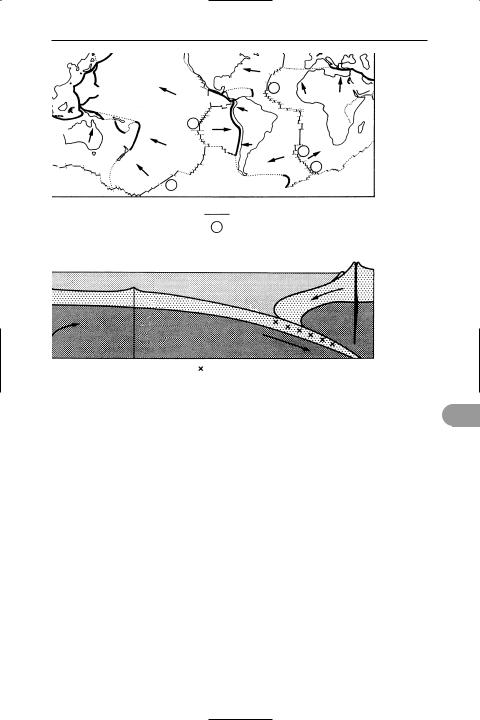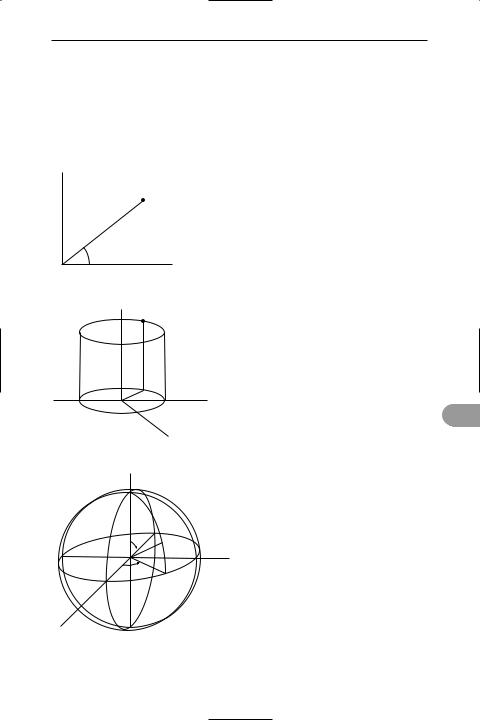
A Dictionary of Science
.pdf
plasma protein |
636 |
to regulate the Ûow of materials and signals into and out of the cell; this is accomplished, for example, by membrane proteins that act as *ion channels or as *receptors for signal molecules arriving at the cell surface. The plasma membrane is the site of junctions with neighbouring cells and forms attachments to the *extracellular matrix, thus ensuring tissue integrity. In plants, fungi, bacteria, and many protoctists, it helps in assembling a cell wall or capsule on its outer surface.
plasma protein Any of the protein constituents of blood plasma. They comprise *albumins, *globulins, and *Übrinogen.
plasmasol The specialized inner sol-like *cytoplasm of living cells that move by producing *pseudopodia. Compare plas-
magel.
plasmid A structure in bacterial cells consisting of DNA that can exist and replicate independently of the chromosome. Plasmids provide genetic instructions for certain cell activities (e.g. resistance to antibiotic drugs). They can be transferred from cell to cell in a bacterial colony. Plasmids are widely used as *vectors to produce recombinant DNA for *gene cloning.
See also genetically modified organisms
(Feature).
pplasmin (Übrinase; Übrinolysin) An enzyme, present in blood plasma, that
breaks down a blood clot by destroying the Übrin threads of the clot and by inactivating factors involved in blood clotting,
such as prothrombin and the *clotting factors. This occurs during *Übrinolysis. Plasmin is derived from an inactive precursor, *plasminogen.
plasminogen The inactive precursor of the enzyme *plasmin. Plasminogen is in-
corporated into blood clots and is converted to plasmin during *Übrinolysis.
plasmodesmata (sing. plasmodesma) Fine cytoplasmic strands that connect the *protoplasts of adjacent plant cells by passing through their cell walls and thus permit the passage of substances between cells. Plasmodesmata are cylindrical in shape (about 20–40 nm in diameter) and are lined by the plasma membrane of the two adjacent cells. The endoplasmic reticula of the two adjacent cells are con-
nected by a narrower structure, the desmotubule, which runs through the centre of a plasmodesma.
plasmolysis The loss of water by *osmosis from a plant cell to the extent that the cytoplasm shrinks away from the cell wall. This happens when the cell is placed in a solution that has a higher solute concentration than that of the cell sap, i.e. it has a lower (more negative) *water potential, since water always moves from an area of high water potential to an area of low water potential. Compare turgor.
plasmon A *collective excitation for quantized oscillations of the electrons in a metal.
plaster of Paris The hemihydrate of *calcium sulphate, 2CaSO4.H2O, prepared by heating the mineral gypsum. When ground to a Üne powder and mixed with water, plaster of Paris sets hard, forming interlocking crystals of gypsum. The setting results in an increase in volume and so the plaster Üts tightly into a mould. It is used in pottery making, as a cast for setting broken bones, and as a constituent of the plaster used in the building industry.
plasticity The property of solids that causes them to change permanently in size or shape as a result of the application of a stress in excess of a certain value, called the yield point.
plasticizer A substance added to a synthetic resin to make it Ûexible. See plastics.
plastics Materials that can be shaped by applying heat or pressure. Most plastics are made from polymeric synthetic *resins, although a few are based on natural substances (e.g. cellulose derivatives or shellac). They fall into two main classes.
Thermoplastic materials can be repeatedly softened by heating and hardened again on cooling. Thermosetting materials are initially soft, but change irreversibly to a hard rigid form on heating. Plastics contain the synthetic resin mixed with such additives as pigments, plasticizers (to improve Ûexibility), antioxidants and other stabilizers, and Üllers. See Chronology.
plastid An *organelle within a plant cell, often occurring in large numbers. Apart from the nucleus, plastids are the

637
PLASTICS
1851 |
Scottish chemist Charles Macintosh (1766–1843) makes ebonite (from |
|
|
|
rubber). |
|
|
1855 |
British chemist Alexander Parkes (1813–90) patents Parkesine, a plastic |
|
|
|
made from nitrocellulose, methanol, and wood pulp; it is later called |
|
|
|
‘celluloid’. |
|
|
1860 |
British chemist Charles Williams (1829–1910) prepares isoprene (synthetic |
|
|
|
rubber). |
|
|
1868 |
US printer John Hyatt (1837–1920) develops commercial process for |
|
|
|
making celluloid. |
|
|
1884 |
French chemist Hilaire de Chardonnet (1839–1924) develops process for |
|
|
|
making rayon. |
|
|
1892 |
British chemists Edward Bevan (1856–1921) and Charles Cross |
|
|
|
(1855–1935) develop the viscose process for making rayon. |
|
|
1899 |
British chemist Frederick Kipping (1863–1949) discovers silicone plastics. |
|
|
1901 |
German chemists Krische and Spitteler make formaldehyde–casein plastic |
|
|
|
(Galalith). |
|
|
1905 |
Belgian-born US chemist Leo Baekland (1863–1944) invents Bakelite. |
|
|
1912 |
Swiss chemist Jacques Brandenberger produces Cellophane (viscose |
|
|
|
cellulose film). |
|
|
1913 |
US Formica Insulation company markets plastic laminate made from |
|
|
|
formaldehyde resins. |
|
|
1918 |
Hans John prepares urea–formaldehyde resin. |
|
|
1926 |
German chemist Hermann Staudinger (1881–1965) discovers the polymeric |
|
|
|
nature of plastics. |
|
|
|
|
|
|
1930 |
US chemist Waldo Semon develops PVC (polyvinyl chloride). |
p |
|
|
|
||
1930 |
Canadian chemist William Chalmers discovers polymethylmethacrylate |
|
|
|
|
||
|
(Perspex and Plexiglass). |
|
|
1930 |
German chemists at IG Farbenindustrie produce polystyrene. |
|
|
1931 |
Wallace Carothers invents nylon. |
|
|
1938 |
US chemist Roy Plunkett produces polytetrafluoroethene (PTFE). |
|
|
1939 |
British company ICI develops commercial process for making polyethene. |
|
|
1941 |
British chemists John Whinfield (1901–66) and J. Dickson develop Terylene |
|
|
|
(Dacron). |
|
|
1941 |
German company IG Farbenindustrie produces polyurethane. |
|
|
1943 |
US Dow Corning company produces silicone plastics. |
|
|
1947 |
British chemists produce acrylic fibres. |
|
|
1953 |
German chemist Karl Ziegler (1896–1973) discovers catalyst for making |
|
|
|
high-density polyethene. |
|
|
1954 |
Italian chemist Giulio Natta (1903–79) develops industrial process for |
|
|
|
making high-density polyethene (using Ziegler catalyst). |
|
|
1989 |
Italian company Ferruzzi produces biodegradable plastic |
|
|
|
(based on starch). |
|
|

plastoglobulus |
638 |
largest solid inclusions in a plant cell. For convenience they are classiÜed into those containing pigments (*chromoplasts) and those that are colourless (*leucoplasts), although changes from one to the other frequently occur. Plastids develop from proplastids, colourless bodies found in meristematic and immature cells; they also arise by division of existing plastids.
See also chloroplast.
plastoglobulus (pl. plastoglobuli) A densely staining droplet found, often in large numbers, in plastids of plant cells. Plastoglobuli consist of lipid pigment and are especially prominent in coloured plastids (*chromoplasts), for example in ripening fruits. Plastoglobuli also occur in chloroplasts, but are masked by the green chlorophyll. When the chlorophyll breaks down as the leaves start to die in autumn, the pigmented plastoglobuli become apparent as the red or yellow ‘fall’ colours.
plastron See carapace.
platelet (thrombocyte) A minute discshaped cell fragment in mammalian blood. Platelets are formed as fragments of larger cells (megakaryocytes) found in red bone marrow; they have no nucleus. They play an important role in *blood clotting, releasing thromboxane A2 (see
pprostaglandin), serotonin, and other chemicals in response to local tissue damage, which causes a chain of events leading to the formation of a plug at the site of the damage, thus preventing further blood loss. There are about 250 000 platelets per cubic millimetre of blood.
platelet-derived growth factor See growth factor.
plate tectonics The theory, developed in the early 1960s, that the surface of the earth is made of lithospheric plates, which have moved throughout geological time resulting in the present-day positions of the continents. The theory explains the locations of mountain building as well as earthquakes and volcanoes. The rigid lithospheric plates consist of continental and oceanic crust together with the upper mantle, which lie above the weaker plastic asthenosphere. These plates move relative to each other across the earth. Six major plates (Eurasian, American, African,
PaciÜc, Indian, and Antarctic) are recognized, together with a number of smaller ones. The plate margins (boundaries) coincide with zones of seismic and volcanic activity.
A constructive (or divergent) plate margin occurs when two plates move away from each other. It is marked by a midoceanic ridge where basaltic material wells up from the mantle to form new oceanic crust, in a process known as seaÛoor spreading. The production of new crust at constructive plate margins is compensated for by the destruction of material along a destructive (or convergent) plate margin. Along these margins, which are also known as subduction zones and marked by an oceanic trench, one plate (usually oceanic) is forced to plunge down beneath the other (which may be continental or oceanic). The crust becomes partially melted and rises to form a chain of volcanoes in the upper plate parallel to the trench. When two continental plates collide the compression results in the formation of mountain chains (e.g. the Himalayas formed by the collision of the Indian and Eurasian plates). A third type of plate margin – the transform plate margin – occurs where two plates are slipping past each other.
platinum Symbol Pt. A silvery white metallic *transition element (see also platinum metals); a.n. 78; r.a.m. 195.09; r.d. 21.45; m.p. 1772°C; b.p. 3827±100°C. It occurs in some nickel and copper ores and is also found native in some deposits. The main source is the anode sludge obtained in copper–nickel reÜning. The element is used in jewellery, laboratory apparatus (e.g. thermocouples, electrodes, etc.), electrical contacts, and in certain alloys (e.g. with iridium or rhodium). It is also a hydrogenation catalyst. The element does not oxidize nor dissolve in hydrochloric acid. Most of its compounds are platinum(II) or platinum(IV) complexes.
platinum black Black Ünely divided platinum metal produced by vacuum evaporation and used as an absorbent and a catalyst.
platinum metals The three members of the second and third transition series immediately proceeding silver and gold:

639 |
|
|
|
Platyhelminthes |
|
Eurasian |
|
|
1.0 |
|
|
|
|
|
|
|
|
|
Eurasian |
|
|
|
American |
|
|
|
|
Caribbean |
Arabian |
|
Philippine |
|
1.4 |
|
|
|
Cocos |
African |
|
1.5 |
|
|
||
|
Pacific |
|
||
|
|
|
|
Indo-
Australian
3
Antarctic
16 Nazca American
2.2
1.5
Scotia
4
Antarctic
direction of plate movement |
|
|
constructive plate margins |
|
|
transform faults |
|
3 |
spreading rates (centimetres per year) |
|
|
destructive plate margins (subduction zones) |
|
|
|
|
|
The lithospheric plates |
|
|
continent |
|
|
mid-ocean ridge |
ocean |
|
|
|
|
|
|
|
|
|
|
+ |
lithosphere |
|
trench |
|
|
|
|
|
|
|
|
+ + |
asthenosphere |
|
|
|
|
+ |
|
|
|
||
|
|
|
|
|
|
|
|
|
|
|
|
+ major earthquake foci |
|
minor earthquake foci |
p |
||
Cross-section showing a constructive plate margin, where two plates are drawing apart along a mid-ocean ridge, and a destructive plate margin, where the oceanic plate is being subducted below the continental plate. Volcanic activity and earthquakes are associated with these margins
Plate tectonics
ruthenium (Ru), rhodium (Rh), and palladium (Pd); and osmium (Os), iridium (Ir), and platinum (Pt). These elements, together with iron, cobalt, and nickel, were formerly classed as group VIII of the periodic table. The platinum-group metals are relatively hard and resistant to corrosion and are used in jewellery and in some industrial applications (e.g. electrical contacts). They have certain chemical similarities that justify classifying them together. All are resistant to chemical attack. In solution they form a vast range of complex ions. They also form coordination compounds with carbon monoxide and other pi-bonding ligands. A number
of complexes can be made in which a hydrogen atom is linked directly to the metal. The metals and their organic compounds have considerable catalytic activity. See also transition elements.
Platyhelminthes A phylum of invertebrates comprising the Ûatworms, characterized by a Ûattened unsegmented body. The simple nervous system shows some concentration of cells at the head end. The mouth leads to a simple branched gut without an anus. Flatworms are hermaphrodite but self-fertilization is unusual. Many species are parasitic. The phylum contains the classes *Turbellaria (planari-

Playfair, John |
640 |
ans), *Trematoda (Ûukes), and *Cestoda (tapeworms).
Playfair, John See hutton, james.
pleiomorphism The existence of distinctly different forms during the life cycle of an individual, e.g. the caterpillar, pupa, and winged adult of a butterÛy.
Pleistocene The earlier epoch of the *Quaternary period (compare holocene). It extended from the end of the Pliocene, about 2 million years ago, to the beginning of the Holocene, about 10 000 years ago. The Pleistocene is often known as the Ice Age as it was characterized by a series of glacials, in which ice margins advanced towards the equator, separated by interglacials when the ice retreated. See also ice age.
pleochroic Denoting a crystal that appears to be of different colours, depending on the direction from which it is viewed. It is caused by polarization of light as it passes through an anisotropic medium.
pleura (pleural membrane) The double membrane that lines the thoracic cavity and covers the exterior surface of the lungs. It is a *serous membrane forming a closed sac, with a small space (the pleural
pcavity) between the two layers.
plexus A compact branching network of nerves or blood vessels, such as the brachial plexus – a network of spinal nerves that supply branches to the forelimbs in vertebrates. See also choroid plexus.
Pliocene The Üfth and Ünal epoch of the *Tertiary period. Preceded by the Miocene and followed by the Pleistocene, it began about 5.1 million years ago and lasted for about 3 million years. Mammals similar to modern forms existed during the epoch and the australopithecines (see australopithecus), early forerunners of humans, appeared.
plumbago See carbon.
plumbane (lead(IV) hydride) An ex-
tremely unstable gas, PbH4, said to be formed by the action of acids on magne- sium–lead alloys. It was Ürst reported in 1924, although doubts have since been ex-
pressed about the existence of the compound. It demonstrates the declining stability of the hydrides in group 14. More stable organic derivatives are known; e.g. trimethyl plumbane, (CH3)3PbH.
plumbate A compound formed by reaction of lead oxides (or hydroxides) with alkali. The oxides of lead are amphoteric (weakly acidic) and react to give plumbate ions. With the lead(IV) oxide, reaction with molten alkali gives the plumbate(IV) ion
PbO2 + 2OH– → PbO32– + H2O
In fact, various ions are present in which the lead is bound to hydroxide groups, the principal one being the hexahydroxoplumbate(IV) ion Pb(OH)62–. This is the negative ion present in crystalline ‘trihydrates’ of the type K2PbO3.3H2O. Lead(II) oxide gives the trihydroxoplumbate(II) ion in alkaline solutions
PbO(s) + OH–(aq) + H2O(l) →
Pb(OH)32–(aq)
Plumbate(IV) compounds were formerly referred to as orthoplumbates (PbO44–) or metaplumbates (PbO32–). Plumbate(II) compounds were called plumbites.
plumbic compounds Compounds of lead in its higher (+4) oxidation state; e.g. plumbic oxide is lead(IV) oxide, PbO2.
plumbite See plumbate.
plumbous compounds Compounds of lead in its lower (+2) oxidation state; e.g. plumbous oxide is lead(II) oxide, PbO.
plumule 1. (in zoology) A *down feather. 2. (in botany) The part of a plant embryo that develops into the shoot system. It consists of the stem apex and Ürst leaves. In seedlings showing *epigeal germination the plumule grows above the soil surface together with the cotyledons; in seeds showing *hypogeal germination, the plumule alone emerges. Compare radicle.
pluripotent See stem cell.
Pluto The outermost planet in the *solar system and the one whose orbit has the highest eccentricity (0.2488) and inclination (17.14°). Its mean distance from the sun is 5.9 × 109 km but at perihelion, owing to the high eccentricity of the

641 |
point mutation |
orbit, it is closer to the sun than Neptune at about 4480 × 106 km. Its *sidereal period is 248.02 years. Pluto was discovered in 1930 by Clyde Tombaugh (1906–97) although its presence had been previously predicted. In 1978 Pluto was discovered to have a close satellite, provisionally named Charon, and estimates of Pluto’s diameter have been reduced from about 5900 km to about 2390 km. The diameter is still not well established. Pluto and Charon appear to be composed mostly of ice with a mean temperature of about 50 K.
plutonium Symbol Pu. A dense silvery radioactive metallic transuranic element belonging to the *actinoids; a.n. 94; mass number of most stable isotope 244 (halflife 7.6 × 107 years); r.d. 19.84; m.p. 641°C; b.p. 3232°C. Thirteen isotopes are known, by far the most important being pluto- nium–239 (half-life 2.44 × 104 years), which undergoes *nuclear Üssion with slow neutrons and is therefore a vital power source for *nuclear weapons and some *nuclear reactors. About 20 tonnes of plutonium are produced annually by the world’s nuclear reactors, a detailed inventory of every gram of which is kept in order to prevent its military misuse. The element was Ürst produced by Seaborg, McMillan, Kennedy, and Wahl in 1940.
pod See legume.
podzol (podsol) |
A type of soil that forms |
|
thin litter layer |
coniferous trees |
|
A0 horizon |
||
partly decomposed |
||
litter |
A1 |
|
|
||
dark-coloured |
|
|
humus |
|
|
ash-grey sandy |
A2 |
|
layer |
||
|
||
iron pan (not |
|
|
always present) |
|
|
reddish-brown |
B |
|
layer |
|
|
weathering |
|
|
parent material |
C |
|
(e.g. sandstone) |
|
Podzol soil profile
under cool humid conditions where the vegetation is coniferous or heath. It is characteristic of the taiga zones of Eurasia and North America. The soil has an ashencoloured upper layer (the A horizon) overlying a layer (the B horizon) containing iron or humus that has been leached down from the A horizon and redeposited.
poikilothermy The passive variation in the internal body temperature of an animal, which depends on the temperature of the environment. All animals except birds and mammals exhibit poikilothermy and are described as *ectotherms. Although unable to maintain a constant body temperature, they can respond to compensate for very low or very high temperatures. For example, the tissue composition (especially cell osmotic pressure) can change to regulate the blood Ûow to peripheral tissues (and thus increase heat loss or heat absorption), and the animals can actively seek sun or shade. Seasonal changes in metabolism are usually under hormonal control. In particularly hot climates, ectotherms may undergo *aestivation to escape the heat.
Compare homoiothermy. point-contact transistor See transistor.
|
|
|
point defect See crystal defect. |
p |
|
point discharge See corona. |
|
|
point group The group formed by all |
|
|
the symmetry operations applied to a pat- |
|
|
tern arranged around a Üxed point. The |
|
|
symmetry operations of molecules form |
|
|
point groups. There are 32 point groups, |
|
|
called crystallographic point groups, that |
|
|
have symmetries that are also compatible |
|
|
with the translational symmetries of crys- |
|
|
tals. |
|
|
point mutation (gene mutation) A |
|
|
change in the nucleotide sequence of the |
|
|
DNA within a gene; a gene in which such |
|
|
a change has occurred is known as a *mu- |
|
|
tant gene or allele. The DNA sequence can |
|
|
be altered in several ways; for example by |
|
|
*insertion, *substitution, *deletion, and |
|
|
*inversion. Point mutations result in a |
|
|
misreading of the genetic code during the |
|
|
translation phase of protein synthesis and |
|
|
usually change the order of amino acids |
|
|

poise |
642 |
making up a protein, which may or may not affect the function of that protein.
Compare chromosome mutation; single nucleotide polymorphism. See also mutation.
poise A *c.g.s. unit of viscosity equal to the tangential force in dynes per square centimetre required to maintain a difference in velocity of one centimetre per second between two parallel planes of a Ûuid separated by one centimetre. 1 poise is equal to 10–1 N s m–2.
Poiseuille’s equation An equation relating the volume Ûow rate, V, of a Ûuid through a cylindrical tube to the pressure difference, p, between the ends of the tube: V = πpr4/8lη, where r is the radius and l the length of the tube; η is the viscosity of the Ûuid. It applies if the Reynolds number is less than 2000 and was Ürst stated by Jean Louis Poiseuille (1799–1869).
poison 1. (in biology) Any substance that is injurious to the health of a living organism. 2. (in chemistry) A substance that prevents the activity of a catalyst. 3. (in physics) A substance that absorbs neutrons in a nuclear reactor and therefore slows down the reaction. It may be added intentionally for this purpose or
pmay be formed as a Üssion product and need to be periodically removed.
Poisson distribution In *statistics, a probability distribution that represents the number of events that occur ran-
domly in a given time at an average rate λ, written as Po(λ). The corresponding probabilities are given by P(k) = e–λλk/r! where k = 0, 1, 2, 3,… Such a distribution describes some natural events, such as
radioactive decay; it is also used in analysing trafÜc Ûow in communication systems. When λ is large, the Poisson distribution approximates to a *normal distribution. It was named after the French mathematician and physicist SiméonDenis Poisson (1781–1840). See also normal distribution; t-distribution.
Poisson’s ratio The ratio of the lateral strain to the longitudinal strain in a stretched rod. If the original diameter of
the rod is d and the contraction of the diameter under stress is ∆d, the lateral
strain ∆d/d = sd; if the original length is l and the extension under stress ∆l, the longitudinal strain is ∆l/l = sl. Poisson’s ratio is then sd/sl. For steels the value is between 0.28 and 0.30 and for aluminium alloys it is about 0.33. It was Ürst introduced by Simeon Poisson (1781–1840).
polar body See oogenesis.
polar compound A compound that is either ionic (e.g. sodium chloride) or that has molecules with a large permanent dipole moment (e.g. water).
polar coordinates A system used in analytical geometry to locate a point P, with reference to two or three axes. The distance of P from the origin is r, and the angle between the x-axis and the radius vector OP is θ, thus in two-dimensional polar coordinates the coordinates of P are (r,θ). If the *Cartesian coordinates of P are (x,y) then, x = rcosθ and y = rsinθ.
In three dimensions the point P may be regarded as lying on the surface of a cylinder, giving cylindrical polar coordinates, or on the surface of a sphere, giving spherical polar coordinates. In the former the coordinates of P would be (r,θ,z); in the latter they would be (r,θ,φ) (see illustration).
polarimeter (polariscope) An instrument used to determine the angle through which the plane of polarization of plane-polarized light is rotated on passing through an optically active substance. Essentially, a polarimeter consists of a light source, a polarizer (e.g. a sheet of Polaroid) for producing plane-polarized light, a transparent cell containing the sample, and an analyser. The analyser is a polarizing material that can be rotated. Light from the source is plane-polarized by the polarizer and passes through the sample, then through the analyser into the eye or onto a light-detector. The angle of polarization is determined by rotating the analyser until the maximum transmission of light occurs. The angle of rotation is read off a scale. Simple portable polarimeters are used for estimating the concentrations of sugar solutions in confectionary manufacture. See also photoelasticity.
polarity 1. The property of a cell, tissue, or organism of being structurally and/or

643 |
polarization of light |
functionally different at opposite ends of its long axis. For example, plants consist of roots, which grow in the direction of the force of gravity, and stems, which grow away from the gravitational force (see geotropism). 2. The property of molecules of having an uneven distribution of electrons, so that one part has a positive charge and the other a negative charge.
y |
|
|
P(r, θ) |
|
θ |
O |
x |
two-dimensional coordinates
zP(r, θ, z)
r  θ
θ
y
x
cylindrical polar coordinates
z
θ P(r, θ, φ)
P(r, θ, φ)
O
y
φ
x
spherical polar coordinates
Polar coordinates
polarizability Symbol α. A measure of the response of a molecule to an external electric Üeld. When a molecule is placed in an external electric Üeld, the displacement of electric charge induces a dipole in the molecule (see electric displacement). If the *electric Üeld strength is denoted E and the electrical dipole moment induced by this electric Üeld p, the polarizability α is deÜned by p = αE. To calculate the polarizability from Ürst principles it is necessary to use the quantum mechanics of molecules. However, if regarded as a parameter, the polarizability α provides a link between microscopic and macroscopic theories as in the *Clausius– Mossotti equation and the *Lorentz– Lorenz equation.
polarization 1. The process of conÜning the vibrations of the vector constituting a transverse wave to one direction. In unpolarized radiation the vector oscillates in all directions perpendicular to the direction of propagation. See polarization of light. 2. The formation of products of the chemical reaction in a *voltaic cell in the vicinity of the electrodes resulting in increased resistance to current Ûow and, frequently, to a reduction in the e.m.f. of the cell. See also depolarization. 3. The partial separation of electric charges in an insulator subjected to an electric Üeld.
4. The separation of charge in a polar p *chemical bond.
polarization of light The process of conÜning the vibrations of the electric vector of light waves to one direction. In unpolarized light the electric Üeld vibrates in all directions perpendicular to the direction of propagation. After reÛection or transmission through certain substances (see polaroid) the electric Üeld is conÜned to one direction and the radiation is said to be plane-polarized light. The plane of plane-polarized light can be rotated when it passes through certain substances (see
optical activity).
In circularly polarized light, the tip of the electric vector describes a circular helix about the direction of propagation with a frequency equal to the frequency of the light. The magnitude of the vector remains constant. In elliptically polarized light, the vector also rotates about the direction of propagation but the amplitude

polarizer |
644 |
changes; a projection of the vector on a plane at right angles to the direction of propagation describes an ellipse. Circularly and elliptically polarized light are produced using a *retardation plate.
polarizer A device used to planepolarize light (see polarization of light).
*Nicol prisms or *Polaroid can be used as polarizers. If a polarizer is placed in front of a source of unpolarized light, the transmitted light is plane-polarized in a speciÜc direction. As the human eye is unable to detect that light is polarized, it is necessary to use an *analyser to detect the direction of polarization. Crossing a polarizer and analyser causes extinction of the light, i.e. if the plane of polarization of the polarizer and the plane of the analyser are perpendicular, no light is transmitted when the polarizer and analyser are combined. Both a polarizer and an analyser are components of a *polarimeter.
polarizing angle See brewster’s law.
polar molecule A molecule that has a dipole moment; i.e. one in which there is some separation of charge in the *chemical bonds, so that one part of the molecule has a positive charge and the other a negative charge.
ppolarography An analytical technique having an electrochemical basis. A drop- ping-mercury electrode is used as the cathode along with a large nonpolarizable anode, and a dilute solution of the sample. The dropping-mercury electrode
(DME) consists of a narrow tube through which mercury is slowly passed into the solution so as to form small drops at the end of the tube, which fall away. In this way the cathode can have a low surface area and be kept clean. A variable potential is applied to the cell and a plot of current against potential (a polarogram) made. As each chemical species is reduced at the cathode (in order of their electrode potentials) a step-wise increase in current is obtained. The height of each step is proportional to the concentration of the component. It is also possible to use an electrode formed from a small rotating disc in place of the dropping-mercury electrode. The technique is useful for de-
tecting trace amounts of metals and for the investigation of solvated complexes.
Polaroid Trade name for a doubly refracting material that plane-polarizes unpolarized light passed through it. It consists of a plastic sheet strained in a manner that makes it birefringent by aligning its molecules. Sunglasses incorporating a Polaroid material absorb light that is vibrating horizontally – produced by reÛection from horizontal surfaces – and thus reduce glare.
polaron A coupled electron–ion system that arises when an electron is introduced into the conduction band of a perfect ionic crystal and induces lattice polarization around itself.
polar solvent See solvent.
polar vector A *vector that reverses its sign when the coordinate system is changed to a new system by a reÛection in the origin (i.e. x′i = –xi). Compare axial vector.
pole 1. See magnetic poles; magnetic monopole. 2. The *optical centre of a curved mirror.
pollen The mass of grains containing the male gametes of seed plants, which are produced in large numbers in the *pollen sacs. The pollen grains of insectpollinated plants may be spiny or pitted and are usually larger than those of windpollinated plants, which are usually smooth and light. The pollen grain represents the male *gametophyte generation; it contains two male gamete nuclei. The wall of the mature pollen grain consists of the tough outer wall (exine) and the more delicate narrower intine. The latter gives rise to the *pollen tube. See also pollination.
pollen analysis See palynology.
pollen sac The structure in seed plants in which pollen is produced. In angiosperms there are usually four pollen sacs in each *anther. In gymnosperms variable numbers of pollen sacs are borne on the microsporophylls that make up the male *cone.
pollen tube An outgrowth of a pollen grain, which transports the male gametes

645 |
polyamide |
to the ovule. It will only grow if the pollen grain is compatible with the female tissue. In angiosperms, the pollen grain is deposited on the stigma and the pollen tube grows down through the style and into the ovule. In some conifers, e.g. Pinus (pines), the pollen tube penetrates the *nucellus but does not develop further until the following year, when the female part of the plant is mature. See also embryo sac; fertilization.
pollex The innermost digit on the forelimb of a tetrapod vertebrate. It contains two phalanges (see pentadactyl limb) and in humans and higher primates it is the thumb, which is opposable (i.e. capable of facing and touching the other digits) and gives the hand greater manipulating ability. In some mammals a pollex is absent.
Compare hallux.
pollination The transfer of pollen from an anther (the male reproductive organ) to a stigma (the receptive part of the female reproductive organ), either of the same Ûower (self-pollination) or of a different Ûower of the same species (crosspollination). Cross-pollination involves the action of a pollinating agent to effect transfer of the pollen (see anemophily;
entomophily; hydrophily). See also fertilization; incompatibility.
pollutant Any substance, produced and released into the environment as a result of human activities, that has damaging effects on living organisms. Pollutants may be toxic substances (e.g. *pesticides) or natural constituents of the atmosphere (e.g. carbon dioxide) that are present in excessive amounts. See pollution.
pollution An undesirable change in the physical, chemical, or biological characteristics of the natural environment, brought about by human activities. It may be harmful to human or nonhuman life. Pollution may affect the soil, rivers, seas, or the atmosphere (see air pollution). There are two main classes of *pollutants: those that are biodegradable (e.g. sewage), i.e. can be rendered harmless by natural processes and need therefore cause no permanent harm if adequately dispersed or treated; and those that are nonbiodegradable (e.g. *heavy metals (such as lead) in industrial efÛuents and *DDT and
other chlorinated hydrocarbons used as pesticides), which eventually accumulate in the environment and may be concentrated in food chains. Other forms of pollution in the environment include noise (e.g. from jet aircraft, trafÜc, and industrial processes) and thermal pollution (e.g. the release of excessive waste heat into lakes or rivers causing harm to wildlife). Recent pollution problems include the disposal of radioactive waste; *acid rain; *photochemical smog; increasing levels of human waste; high levels of carbon dioxide and other greenhouse gases in the atmosphere (see greenhouse effect); damage to the *ozone layer by nitrogen oxides, *chloroÛuorocarbons (CFCs), and *halons; and pollution of inland waters by agricultural *fertilizers and *sewage efÛuent, causing eutrophication (see eutrophic). Attempts to contain or prevent pollution include strict regulations concerning factory emissions, the use of smokeless fuels, the banning of certain pesticides, the greater use of renewable energy sources, restrictions on the use of chloroÛuorocarbons, and the introduction, in some countries, of catalytic converters to cut pollutants in car exhausts.
polonium Symbol Po. A rare radioactive metallic element of group 16 (formerly VIB) of the periodic table; a.n. 84; r.a.m.
210; r.d. 9.32; m.p. 254°C; b.p. 962°C. The p element occurs in uranium ores to an ex-
tent of about 100 micrograms per 1000 kilograms. It has over 30 isotopes, more than any other element. The longest-lived isotope is polonium–209 (half-life 103 years). Polonium has attracted attention as a possible heat source for spacecraft as the energy released as it decays is 1.4 × 105 J kg–1 s–1. It was discovered by Marie Curie in 1898 in a sample of pitchblende.
poly- PreÜx indicating a polymer, e.g. polyethene. Sometimes brackets are used in polymer names to indicate the repeated unit, e.g. poly(ethene).
polyamide A type of condensation polymer produced by the interaction of an amino group of one molecule and a carboxylic acid group of another molecule to give a protein-like structure. The polyamide chains are linked together by hydrogen bonding.
